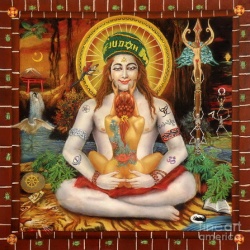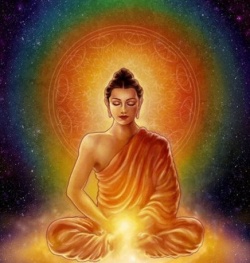Mushi-dokugo
Mushi-dokugo (無師独悟?), sometimes called jigo-jishō (自悟自証?, self-enlightened and self-certified), is a Japanese term used in Zen Buddhism which expresses the phenomenon known as "awakening alone, without a master."
Etymology
Mushi-dokugo (無師独悟) is a Japanese term composed of four Chinese characters, or kanji, meaning "independent realization without a master." The character mu (無) means "without" or "no", shi (師) means "master" or "teacher", doku (独) means "independent" or "alone", and go (悟) means "realization" or "understanding" (satoru), also translated as "Enlightenment" (Satori). When strung together, the characters literally read, "no (無) master (師) independent (独) understanding (悟)." The equivalent Chinese pronunciation is wúshī dúwù.
Examples of mushi-dokugo
Nōnin (died 1196) is an example of mushi-dokugo:
Nonin initially studied Tendai Buddhism, but he apparently became dissatisfied with it, even abandoning the traditional teacher-disciple relationship by declaring himself to be a self-enlightened Zen Rōshi
During the Edo period in Japan, there were a great many priests who proclaimed to be "self-enlightened." These included...
such notables as the Myōshin-ji masters Daigu, Ungo, Isshi and the Sōtō priest Suzuki Shōsan.
The famous Korean master Jinul could also be seen as an example.
Statements on mushi-dokugo
It is...
usually considered suspect since the risk of self-delusion or 'fake-Zen' is always high.
According to William M. Bodiford,
To guarantee that his experience of the truth of Buddhism is genuine, the Zen disciple relies upon his teacher to authenticate and formally acknowledge his Enlightenment.
Dōgen, the founder of the Sōtō school of Japan, acknowledged in his lifetime that such a phenomenon exists. According to Hee-Jin Kim,
[...] Enlightenment-by-oneself, without a teacher" (mushi-dokugo), [is] the ultimate Zen principle that every practitioner had to actualize, even while studying under competent teachers and reading the sutras for a number of years. Dōgen provided this well known dictum with a specific methodological/hermeneutic key that allowed one to unlock the mystery of existence—that is, to open the self and the universe. That key amounted, in essence, to critical, reflective thinking as an integral part of meditation. Without this key, it was impossible to attain one's own salvific independence [...] Meditation and Wisdom alike had to be subjected to critical scrutiny and reassessed in the changing situation
Critical, reflective thinking as an integral part of meditation is mentioned in the fascicles of the Shōbōgenzō. Any-one practising alone or together, without Dharma transmission, may be regarded a Dharma practitioner:
So although shiho alone is not much, no shiho at all qualifies you for nothing but being a Dharma practioner in your own right, a follower of The Buddha way who may practice on his own or along with others. You may even teach the Dharma, but you should not pose as an authorized representative of a lineage or school. Believe it or not, that happens all the time. If you teach without shiho, you should make clear that you are not part of one of the existing schools, but the founder of your own school (which is OK of course, as long as you state so).

